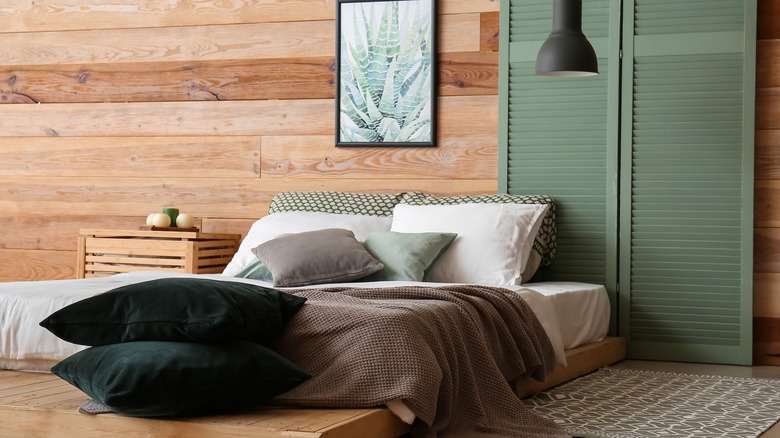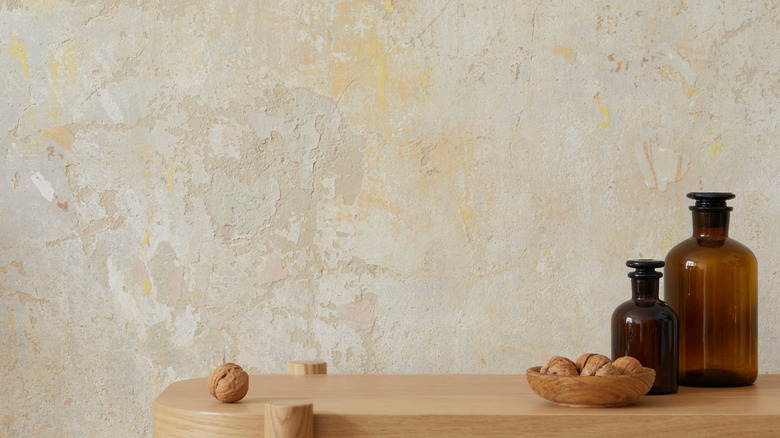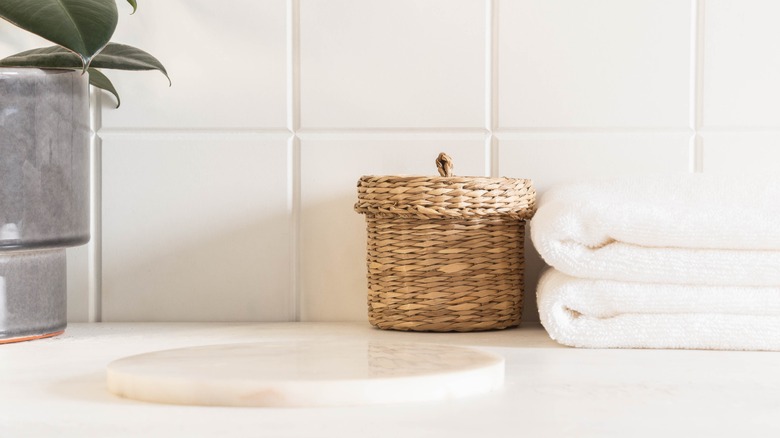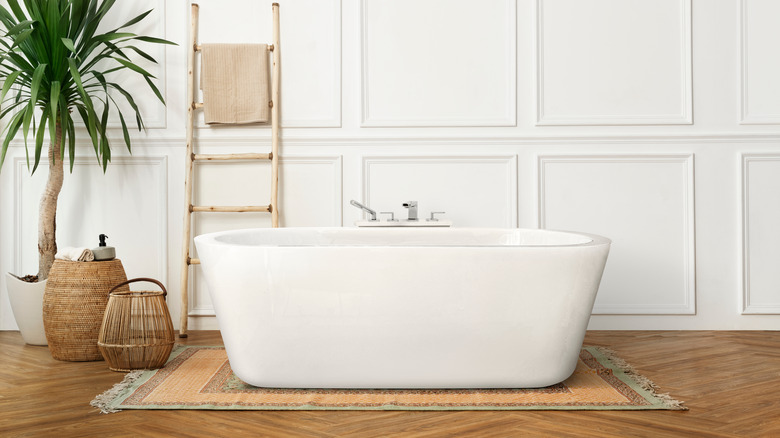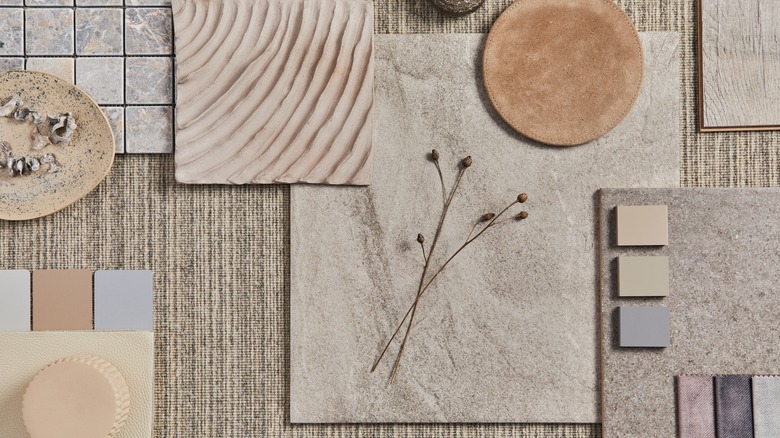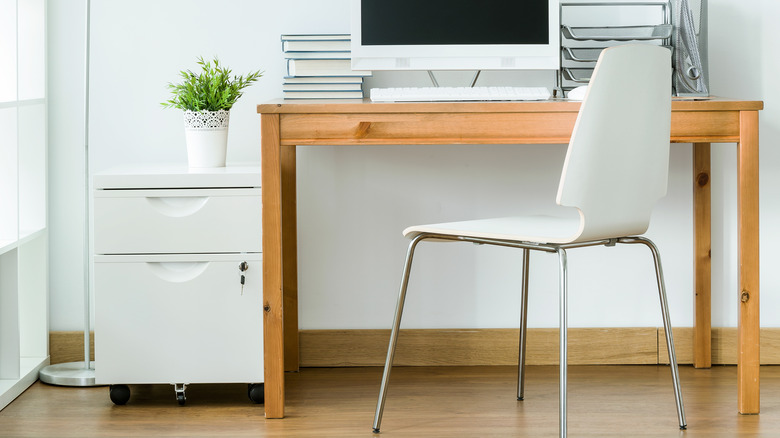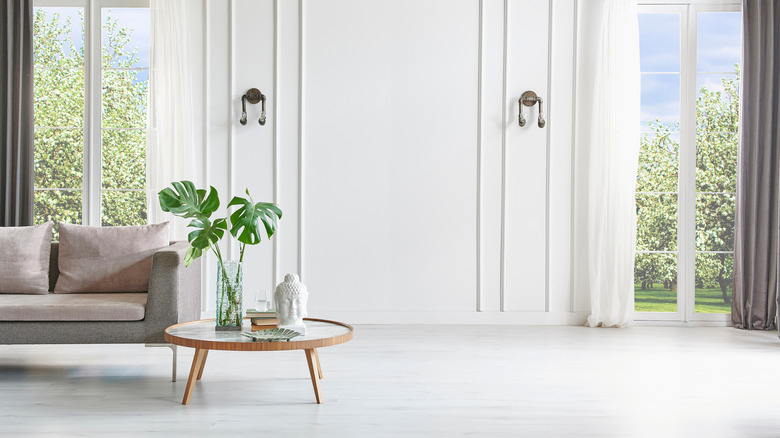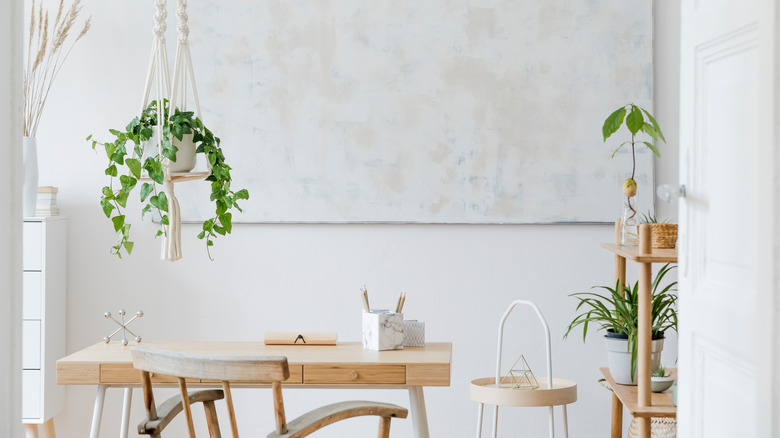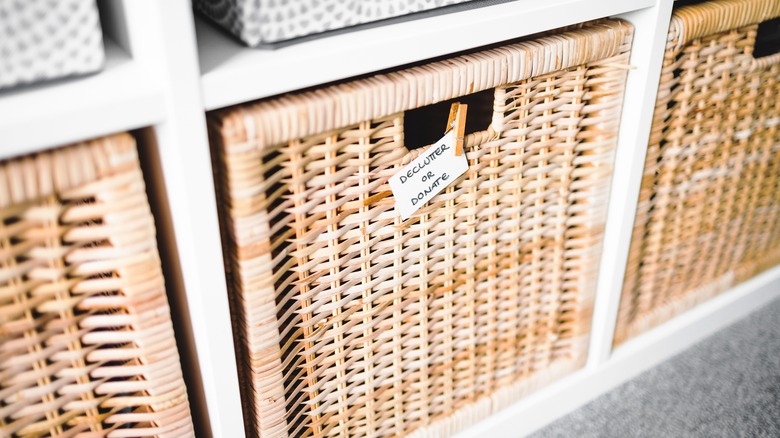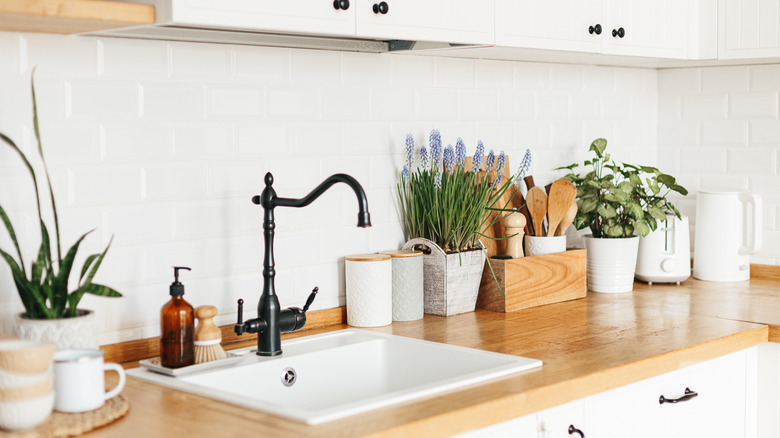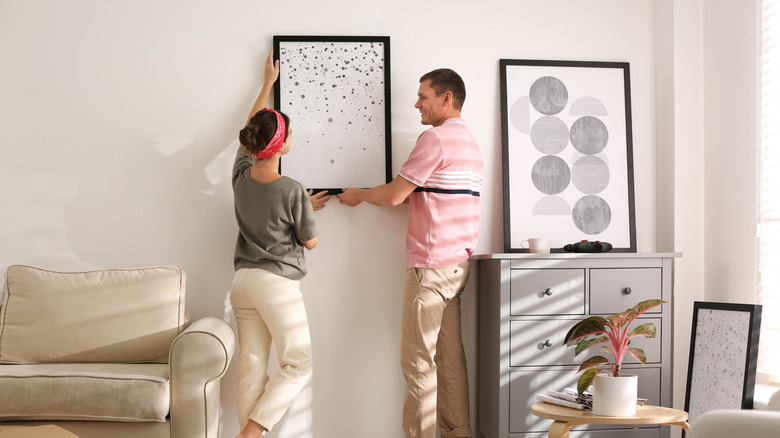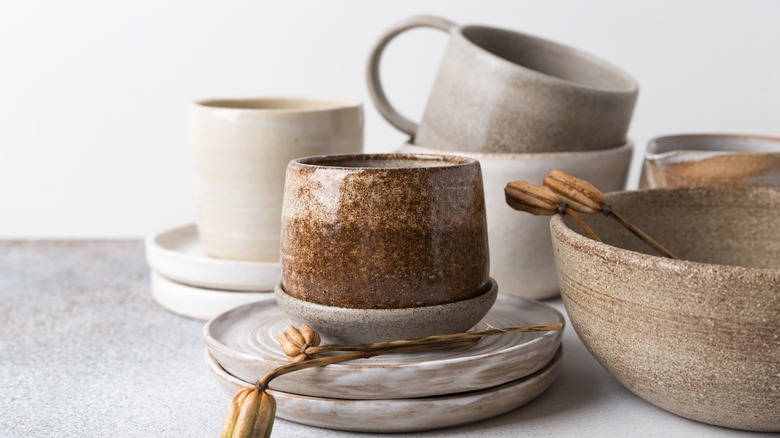A Guide To Japandi Style And How You Can Use It In Your Home
Collaboration in style and design nearly always results in something new and creative. Transitional decor, for example, is the beautiful combination of traditional and contemporary elements, bringing forth a space that embraces the past and present. Japandi style derives from the collaboration of Japanese and Scandinavian decor elements. The combination of these two styles, as reported by Vevano Home, makes perfect sense, as both aesthetics celebrate a love for nature, minimalism, and craftsmanship over being trendy or popular.
Each style has its own unique nuances, such as prioritizing nature and water in interior spaces for Japanese style (via Weiken) or highlighting functionality without sacrificing beauty for Scandinavian (via Scandinavia Standard). While it might just be a seemingly simple combination of two aesthetics, the Japandi style offers a wealth of simple yet cozy design ideas and an overall calm aesthetic. Here are some great tips and tricks for decorating your home with this chic style.
Principles of Japandi design
The core styles that form Japandi design focus on the importance of comfort and promote imperfection, known in the design sphere as hygge and wabi-sabi. According to Japan Objects, wabi-sabi is more of a feeling than a concept, with the two characters in its names translating roughly into "loneliness" and "old and elegant." The rise of technological advancements and idolizing of perfection in many cultures has driven a corresponding appreciation of natural materials, organic processes, and lifestyle philosophies such as wabi-sabi. Regarding art and design, wabi-sabi, in layman's terms, generally means to appreciate the beauty of something in all its forms — perfect but imperfect, especially as it transitions with age. Weathered or worn furniture and accent pieces are ways that wabi-sabi shines in design.
Many thinkers and theorists explore the use of wabi-sabi in culture, similar to the growing popularity of hygge in lifestyle and design. The principles of hygge include gratitude, comfort, and savoring what brings you joy (via AFAR). Hygge decor reflects in individual design pieces, including comfortable throw pillows, warm blankets, great literature, and framed photos of one's family.
Keep things simple
Understanding philosophies like wabi-sabi and hygge is a great way to open one's eyes to the core beliefs of Japanese and Scandi styles and how they have evolved into an ideal pairing. However, to realize a space's full potential with Japandi style methods, several principles should be part of the overall look.
Between the two styles, there is a strong focus on minimalism. According to Coaster Fine Furniture, minimalism is based on simplicity, living with less, and finding the right spot for everything. Through this style collaboration, Japandi demonstrates how minimalism is more than just clutter-free spaces and white walls. This simple style creates a strong sense of ease with minimalist decor, open floor plans, muted colors, and highlighting natural light (via Sefa Stone). These elements are central to what makes Japandi design unique, and there are plenty of ways to embrace a minimalist aesthetic in your home.
Implement sustainable practices
A vital element of the Japandi style is its focus on sustainability. The design preference focuses on making choices and decisions about interiors with the planet in mind. Both aesthetics celebrate the beauty of the natural world, so being kind to the earth is an important step.
As Ray Fiser told the U.S. Global Green Building Council, one of the top aspects of sustainability is the health of a homeowner's indoor environment and the homeowners themselves. "Interior designers offer specialized knowledge of interior materials and FF&E (furniture, fixtures and equipment) that promote good indoor air quality, are toxin-free, and are water/energy-efficient," said Fiser. This knowledge can lead to further conversations down the line that can help make a home more sustainable, whether it's a choice in paint, fixtures, or building materials. No matter where your space sits on the spectrum of living sustainably, you can demonstrate this idea by implementing beautiful wood furniture, recycled or handmade, and wall or floor surfaces made with materials that leave a smaller footprint (via Viccarbe).
Embrace natural materials and textures
Natural materials are best for showcasing Japandi's down-to-earth aesthetic. With these materials, you can easily lean more into the wabi-sabi element of the Japandi style and embrace imperfections. As interior designer Shanty Wijaya told CNN, it's best to "Opt for reclaimed pieces or something that is original or handmade. Use materials that can naturally patina in time, like wood, natural stones and living finish metals." Other materials such as bamboo, cotton, wool, and linen also provide a simple yet natural look and feel.
It's also a good idea to be mindful of your chosen material palette so that elements coexist harmoniously. Wood and bamboo might pair better with certain materials. For example, rattan furniture looks lovely with stone flooring, while brick walls with leather furniture can appear dated. Get creative with your natural materials, whether decorating with a jute rug or a leather sofa (via Travertine Mart).
Neutral colors all the way
Since Japandi highlights simplicity and comfort, palettes associated with this style should replicate these themes. Columbia Paint reports that paint and color do more than cover empty walls. They create an atmosphere and set the tone for a space. While neutrals might initially appear drab or tepid, they create a peaceful and calming environment.
Soft white or cream colors for your walls and rooms are ideal. However, if you're begging for some colors, muted neutrals and warm hues work well, highlighting natural materials like wood. Designer Laila Rietbergen told Oakywood that "The color base is soft, raw, and monochromatic — but with occasional darker accents, such as black, brown, and terracotta. You can even layer these tones and textures to create a more balanced, sophisticated look and a stable area to add pops of color or complementary pieces (via HPA Design Group). Overall, neutral hues will help maximize natural light and bring a calm, relaxing energy.
Maximize natural light
As Theo Richardson told The New York Times, "Light is a powerful thing ... The right light lifts the mood, inspires productivity and motivates us." You can use natural light to create balance within a Japandi space, showcasing subtle moods and materials. Bare windows help promote this airy atmosphere, which you can aid by pulling your furniture away from the windows to let more sunlight pass through (via Dig This Design). One way to get in the right mood is to pick the correct lightbulbs. You can determine the color tones of your bulbs by checking the package. Warmer colors show at lower ranges (2700K to 3000K), and cool tones are higher (5000K to 6500K) (via Hiller). They also recommend warmer colors for bedrooms and living rooms and whiter or bright blue tones in kitchens and bathrooms.
There are a few ways to shift to a soft lighting design without bringing an electrician on board. Look for table and floor lamps, which will give off a subtle glow (via Dianne Decor). To enhance your Japandi stylings, try dimmable recessed lighting in larger areas and under cabinets in the kitchen. These space out the light sources and add functionality to your design.
Function over form
Experts in the interior design industry say that some of the biggest mistakes include prioritizing the look of a decor item rather than its purpose or function, per Florida Leather Gallery. Japandi style emphasizes this feature by focusing on versatile furnishings. First thing's first: function over fashion when it comes to everything. Who wants to sit in a chair you can't use or in a room where it doesn't feel comfortable to spend time?
The best way to plan for function is to approach the space like an architect drawing the blueprints of a home. Ask yourself what your daily routine looks like and if it's conducive to your floor plan. Choose furniture that harmoniously works with your life and everything else in the room. Use mobile furniture, such as bedside tables, armchairs, consoles, and chairs, to prioritize function. This purposeful approach will lead to you buying less stuff in the long run (via Medium).
Prioritize simple, yet classic furniture
Simple is always first when designing a Japandi space. Keeping it minimal might seem challenging, but it will pay off. The first thing to consider when choosing Japandi furniture is height. Low-profile pieces are ideal for making your space feel free-flowing and calm, per Grain & Frame. Look for items like low-back couches, chairs, and simple coffee tables. If you prefer the Scandinavian side of Japandi, you can find styles with curved shapes (via Bassett Furniture). The main idea is to embrace open space with clean, subtle furniture.
Wood furniture is ideal, but you can also use any natural material like bamboo, iron, or glass. Designers recommend the Bentwood chair as a classic furniture piece with a minimalist appeal (via HGTV). For the bedroom, a platform bed frame can work beautifully, as its streamlined wood frame and low headboard take up less space along the wall and floor.
Create clean, strong lines
According to INVIEW Interior Design, minimalism in interior design typically requires a focus on clean lines and streamlined silhouettes. The same can be said for Japandi style, with a deeper focus on lines and shapes. Simple yet strong lines connect and balance the different pieces of the room. Strong lines are essentially unbroken and create a feeling of stability (via Paradigm Interiors). Horizontal lines seen in crown molding or baseboards provide a masculine, powerful strength with timeless style. On the other hand, curved or sweeping lines come off as creative and organic, such as the curved lines of a chair set at a circular table.
You can decide what type of unbroken lines feel best to you. Consider every aspect, including furniture, flooring, and wall art placement. Shelves with straight, clean edges juxtaposed with soft shapes are a perfect way to incorporate Japandi design in your home.
Organize and declutter
Minimalist design styles like Japandi mean less is more, especially for clutter in the home. Decluttering is a great way to honor the philosophies behind this aesthetic. To declutter your home, keep in mind the philosophical ideas of wabi-sabi and hygge central to Japandi. For hygge, everything focuses on comfort and gratitude, which often applies to personal items or things that make you cozy. Find a way to organize your cups and mugs or curate your candle collection to a modest amount. According to A Blissful Nest, consider what fits and which items are in the best shape. Remove anything chipped or no longer functional.
To follow the principle of wabi-sabi, recycle less-than-perfect baskets for storage or give antique furniture new life without purchasing something new. You can organize in alignment with Japandi ideals by using a sustainable four-box method. Label the boxes for trash, donate, keep, or relocate and start your decluttering journey (via Becoming Minimalist).
Bring nature inside with greenery and plants
Living or not, adding a thoughtful nod to nature complements a Japandi-styled space, as both Japanese and Scandinavian styles embrace the importance of connecting to nature. Many interior design methods that align with Japandi ideals are perfect for adding plant life to your space. Natural light, for example, is a vital aspect of Japandi and for plants. Spruce up these spaces with plant life that appreciates light and space, such as the Chinese Fan Palm, per Plant the Future. You can also do this with herbs, using shallow shelves on a bare wall or small pots on your counter (via Dig This Design).
There are other ways to bring plants into the living space. For example, art works well, and you can add some beautiful nature scenes to your walls with paintings or photographs (via Blue and Green Tomorrow). Pick art that reminds you of a place you love or wish to visit, whether a beautiful waterfall or a lush green forest. To add a more personal touch, display some found natural items, perhaps a unique collection of stones, shells, or pieces of wood.
Choose intentional accent pieces
Japandi design strives to decorate with intention and purpose to avoid excess. Being intentional starts from the bare bones of a space, sizing up your wall and floor space and seeing how it compares to what you own or plan to buy. As designer Bria Hammel told Better Homes & Gardens, "Measuring is important so that you don't have under-scaled pieces in your space. Having the right proportions of items in your space make it feel intentional from the very beginning." Not acting intentionally with your design can lead to clutter, the antithesis of the Japandi style (via CB2). Reimagine existing pieces to cut down on clutter and give your furniture new life.
Accent pieces used in this style should follow a similar pattern, though that doesn't mean your accents have to be small or basic. Intentional decorating is about putting yourself back into your home. Consider hygge sensibilities of surrounding yourself with things that make you grateful and happy. Outfit your space with meaningful items that tell your story like souvenirs or long-lasting keepsakes.
Craftsmanship is key
Highlighting beautiful craftsmanship in your home is an excellent way to add a personal touch. What is great about this aspect of Japandi is that it gives the designer time to look at things more carefully, even at a slower pace, to gain an appreciation for careful craftsmanship. Per Pigmentti, decorative arts are by their very nature slow and steady, and artisans and craftspeople respect their materials and tools.
Showcasing handmade pieces will showcase refined, beautiful details, which can balance out a simple design layout while also implementing wabi-sabi. Pottery is an excellent way to incorporate handmade items. Even with some nicks or chipped paint, ceramic art remains beautiful with its imperfection and is thoroughly one of a kind (via Culture Trip). Add some ceramic mugs and plates to your kitchen cabinets or display pieces on open shelving. This tip also works well with furniture. Many handcrafted items feature natural materials, perfect for the Japandi aesthetic.
Get some rest
As the world around us evolves, styles like Japandi that rely heavily on keeping things simple and reflective of nature only become more popular. As designer Laila Rietbergen told Oakywood, "our home is supposed to be a place where we can cut off lots of external stimuli, rest and recharge our batteries."
Japandi style, when you break it down, is about finding true tranquility in your home and making it a place to rest and recharge. Central Japandi ideals, such as decluttering, bringing the outdoors inside, and using soft light, are the perfect stepping stones toward achieving a peaceful home. There are many ways to make your home a comforting place to rest and recharge, including utilizing the senses. Try lighting your favorite scented candles that emit nature-based scents. "Eucalyptus, geranium, and chamomile are some of my favorites, and they bring a soothing, spa-like quality to any room," said interior designer Caitlin Murray to Better Homes & Gardens. For sound, play some peaceful background music to reduce stress levels (via Verywell Mind).
